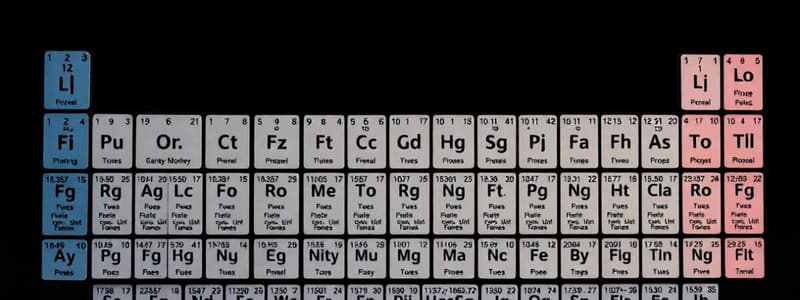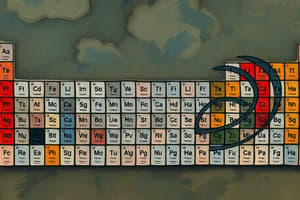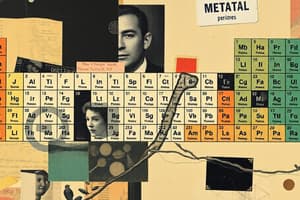Podcast
Questions and Answers
Which statement about metals is correct?
Which statement about metals is correct?
- Metals are typically brittle and shatter easily.
- Metals are solid at room temperature except for gallium. (correct)
- All metals are gases at room temperature.
- Metals are generally poor conductors of heat.
What distinguishes alkali metals from alkaline earth metals?
What distinguishes alkali metals from alkaline earth metals?
- Alkali metals are found freely in nature.
- Alkali metals have three valence electrons.
- Alkaline earth metals are more reactive than alkali metals.
- Alkali metals belong to group one of the periodic table. (correct)
Which of the following accurately describes isotopes?
Which of the following accurately describes isotopes?
- Isotopes share the same number of protons but differ in neutrons. (correct)
- Isotopes of an element differ in the number of protons.
- All isotopes have varying electron arrangements.
- They have different chemical properties but identical physical properties.
What characteristic of noble gases contributes to their stability?
What characteristic of noble gases contributes to their stability?
Which of the following statements regarding chemical properties is accurate?
Which of the following statements regarding chemical properties is accurate?
What is the primary criterion for the organization of the modern periodic table?
What is the primary criterion for the organization of the modern periodic table?
Which group of metals is characterized by high reactivity, especially with water?
Which group of metals is characterized by high reactivity, especially with water?
Which of the following elements is the most abundant non-metal in Earth's crust?
Which of the following elements is the most abundant non-metal in Earth's crust?
What unique characteristic do noble gases possess?
What unique characteristic do noble gases possess?
Which element is recognized for having the highest electronegativity?
Which element is recognized for having the highest electronegativity?
Which group includes elements that are often found as diatomic molecules?
Which group includes elements that are often found as diatomic molecules?
What distinguishes semi-metals (metalloids) from true metals?
What distinguishes semi-metals (metalloids) from true metals?
Which metal is known to be liquid at room temperature?
Which metal is known to be liquid at room temperature?
What is the heaviest naturally occurring element mentioned?
What is the heaviest naturally occurring element mentioned?
Which of the following is a chemical property of matter?
Which of the following is a chemical property of matter?
Which elements are liquid at room temperature?
Which elements are liquid at room temperature?
Which bond type is primarily formed between metals and non-metals?
Which bond type is primarily formed between metals and non-metals?
How many naturally occurring elements are there?
How many naturally occurring elements are there?
Which of the following elements is most commonly used in wiring due to its excellent conductivity?
Which of the following elements is most commonly used in wiring due to its excellent conductivity?
What type of bonding involves sharing electrons?
What type of bonding involves sharing electrons?
What is the primary application of Helium?
What is the primary application of Helium?
Which elements were predicted by Mendeleev before their discovery?
Which elements were predicted by Mendeleev before their discovery?
Which combination of physical properties does NOT include a property of matter?
Which combination of physical properties does NOT include a property of matter?
What characteristic is true of metalloids compared to non-metals?
What characteristic is true of metalloids compared to non-metals?
What characteristic of the modern periodic table allows scientists to predict the properties of undiscovered elements?
What characteristic of the modern periodic table allows scientists to predict the properties of undiscovered elements?
Which group of elements has the highest reactivity?
Which group of elements has the highest reactivity?
How many valence electrons do halogens possess?
How many valence electrons do halogens possess?
Which group of elements is characterized as being shiny, soft, and highly reactive?
Which group of elements is characterized as being shiny, soft, and highly reactive?
Which of the following statements about transition metals is correct?
Which of the following statements about transition metals is correct?
What best describes the stability of noble gases?
What best describes the stability of noble gases?
What is the primary reason heavy metals pose a risk to health?
What is the primary reason heavy metals pose a risk to health?
What type of substance can be broken down by chemical means but not by physical means?
What type of substance can be broken down by chemical means but not by physical means?
Which statement accurately describes the reactivity trend within the chalcogen group?
Which statement accurately describes the reactivity trend within the chalcogen group?
Which of the following elements is characterized as mostly radioactive and unstable?
Which of the following elements is characterized as mostly radioactive and unstable?
What is the primary factor affecting an atom's stability?
What is the primary factor affecting an atom's stability?
In the periodic table, where are semi-metals typically located?
In the periodic table, where are semi-metals typically located?
Which of the following statements accurately describes alkali metals?
Which of the following statements accurately describes alkali metals?
Which of the following states of matter has particles that are held tightly together and possess fixed shapes?
Which of the following states of matter has particles that are held tightly together and possess fixed shapes?
What is typically the least dense state of matter?
What is typically the least dense state of matter?
What is indicated by the atomic mass located within each element's box in the periodic table?
What is indicated by the atomic mass located within each element's box in the periodic table?
What factor allows unstable atoms to become ions?
What factor allows unstable atoms to become ions?
Which of these elements would typically be classified as a non-metal?
Which of these elements would typically be classified as a non-metal?
What role did Dmitri Mendeleev play in the development of the periodic table?
What role did Dmitri Mendeleev play in the development of the periodic table?
Flashcards
What is the primary organizational principle of the periodic table?
What is the primary organizational principle of the periodic table?
The periodic table's order is based on atomic number, which represents the number of protons in an atom's nucleus.
Who is credited with developing the first periodic table?
Who is credited with developing the first periodic table?
Dmitri Mendeleev is credited with creating the first periodic table, arranging elements by atomic mass. He also made predictions about undiscovered elements, later confirmed.
What are groups on the periodic table?
What are groups on the periodic table?
Vertical columns on the periodic table called groups share similar chemical properties due to having the same number of valence electrons.
What are periods on the periodic table?
What are periods on the periodic table?
Signup and view all the flashcards
What are the general characteristics of metals?
What are the general characteristics of metals?
Signup and view all the flashcards
What are the general characteristics of non-metals?
What are the general characteristics of non-metals?
Signup and view all the flashcards
What are metalloids?
What are metalloids?
Signup and view all the flashcards
What are noble gases?
What are noble gases?
Signup and view all the flashcards
Hydrogen
Hydrogen
Signup and view all the flashcards
Uranium
Uranium
Signup and view all the flashcards
Electronegativity
Electronegativity
Signup and view all the flashcards
Ionization Energy
Ionization Energy
Signup and view all the flashcards
Ionic Bond
Ionic Bond
Signup and view all the flashcards
Covalent Bond
Covalent Bond
Signup and view all the flashcards
Copper
Copper
Signup and view all the flashcards
Silicon
Silicon
Signup and view all the flashcards
Lead
Lead
Signup and view all the flashcards
Noble Gases
Noble Gases
Signup and view all the flashcards
Homogeneous mixture
Homogeneous mixture
Signup and view all the flashcards
Heterogeneous mixture
Heterogeneous mixture
Signup and view all the flashcards
Groups on the periodic table
Groups on the periodic table
Signup and view all the flashcards
Periods on the periodic table
Periods on the periodic table
Signup and view all the flashcards
Isotopes
Isotopes
Signup and view all the flashcards
What is the basis of the periodic table?
What is the basis of the periodic table?
Signup and view all the flashcards
How is the periodic table structured?
How is the periodic table structured?
Signup and view all the flashcards
What are metals?
What are metals?
Signup and view all the flashcards
What are nonmetals?
What are nonmetals?
Signup and view all the flashcards
What are alkali metals?
What are alkali metals?
Signup and view all the flashcards
What are alkaline earth metals?
What are alkaline earth metals?
Signup and view all the flashcards
What are transition metals?
What are transition metals?
Signup and view all the flashcards
What are noble metals?
What are noble metals?
Signup and view all the flashcards
What are lanthanides?
What are lanthanides?
Signup and view all the flashcards
Element
Element
Signup and view all the flashcards
Compound
Compound
Signup and view all the flashcards
Mass
Mass
Signup and view all the flashcards
Properties of Metals
Properties of Metals
Signup and view all the flashcards
Properties of Non-metals
Properties of Non-metals
Signup and view all the flashcards
Metalloids
Metalloids
Signup and view all the flashcards
Atomic Number
Atomic Number
Signup and view all the flashcards
Study Notes
Periodic Table Organization
- The periodic table is organized primarily by atomic number, which is the number of protons in an atom.
- Dmitri Mendeleev developed the first periodic table, arranging elements by atomic mass and leaving gaps for undiscovered elements.
- Groups (vertical columns) contain elements with similar chemical properties.
- Periods (horizontal rows) represent different electron energy levels.
Characteristics of Elements
Metals
- General characteristics: malleable, ductile, shiny, good conductors of heat and electricity.
- Examples: Iron (Fe), essential in steel production; Magnesium; Lead (used in batteries)
- Special groups of metals:
- Alkali metals (Group 1): highly reactive with water (e.g., Potassium).
- Alkaline-earth metals (Group 2): reactive but less so than alkali metals (e.g., Magnesium).
- Transition metals (Groups 3-12): hard, shiny, good conductors (e.g., Iron).
- Post-transition metals: less conductive and malleable (e.g., Lead).
Non-Metals
- Characteristics: brittle, poor conductors of heat and electricity.
- Examples: Oxygen (most abundant element in Earth's crust); Carbon (building block of life in organic chemistry).
Semi-Metals (Metalloids)
- Properties of both metals and non-metals.
- Example: Silicon (used in solar cells and computer chips).
Noble Gases (Group 18)
- Inert and non-reactive.
- Examples: Helium (used in balloons and airships); Argon (used in lights).
Special Properties and Trends
- Most metals are solids at room temperature.
- Exceptions: Mercury (liquid metal used in thermometers); Bromine (liquid non-metal).
- Diatomic elements: Non-metals that naturally exist as two-atom molecules (e.g., halogens, Hydrogen).
- Electronegativity: Fluorine has the highest electronegativity.
- Lightest element: Hydrogen (most abundant in the universe).
- Heaviest naturally occurring element: Uranium.
Periodic Trends and Bonding
- Periodic trends are observed due to changes in electron configuration, affecting reactivity, electronegativity, and ionization energy.
- Chemical Bonds:
- Ionic Bonds: Formed between metals and non-metals (e.g., NaCl).
- Covalent Bonds: Formed by sharing electrons (e.g., H₂O).
Uses and Applications of Elements
- Common Uses:
- Copper: Excellent electrical conductivity, used in wiring.
- Silicon: Used in glass, ceramics, and electronics.
- Lead: High density, used in batteries.
Discovery and Prediction
- Gallium and Germanium were predicted by Mendeleev and later discovered, confirming his periodic table structure.
- Number of Naturally Occurring Elements: 98.
Liquid Elements
- Mercury and bromine are liquid at room temperature.
Inner Transition Metals
- The two rows at the bottom of the periodic table.
Gold
- Symbol: Au.
Bond Type
- Ionic bonds typically form between metals and non-metals.
Other Properties
- Halogens (Group 17): highly reactive nonmetals often found as diatomic molecules (Fluorine has highest electronegativity).
- Chalcogens (Group 16): reactive elements including oxygen.
- Rare Earth Elements: Found in the f-block ((inner transition metals))
- Example: Lanthanum.
- Isotopes: Elements that have the same number of protons, but different numbers of neutrons
- Dmitri Mendeleev: Russian chemist who created the periodic table.
- Alkali metals and Alkaline Earth metals: Differences between alkali metals (Group 1 on the periodic table), highly reactive and not found freely in nature, and alkaline earth metals (Group 2), two valence electrons.
Studying That Suits You
Use AI to generate personalized quizzes and flashcards to suit your learning preferences.




